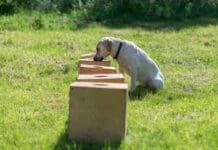[Updated February 5, 2019]
How to exercise yourself at the same time you exercise your dog was the subject of “Fitness Together” in the April 2013 issue of WDJ. But there are many reasons the human half of the equation may not be up for much physical exercise, some permanent and some thankfully temporary. Fear not, there are ways to exercise your dog physically, whether he’s outside at the end of a leash, or inside, playing games that permit him to run around a less-than-active you. Your dog needs exercise; your job is to figure out how to meet that need, even if you can’t join in. A tired dog is a content, well-behaved, relaxed dog, one more likely to choose to snooze while his people are at work.

And choosing snoozing over chewing is more apt to let him remain in his home, allowing him to skip that sad trip to the shelter. Maybe those familiar words shelter workers hear – “I just don’t have enough time for him,” “He needs a place in the country, where he can run,” and all their variants – would be less often heard if only he was happily tuckered out, instead of bored to distraction and destruction. It is possible to get him tired, without knocking yourself out.
Suppose for a moment you’re like me: a lifelong dog owner now in your 70s, with a young dog, large or small (I have one of each), who revels in exercise. Maybe you’re younger, but you’ve suffered an injury or required surgery. There are any number of reasons you can’t be as active as you might (or should) like to be. Here are a few ways to keep your exercise at a minimum, and still tire your dog.
Play Tug!
I can walk just fine, but not as far as it would take to truly tire my 6-year-old Bull Terrier, Zee. By incorporating some random games of tug into our walks, I can, however, increase her exercise while my own remains the same. You can, too! Most dogs love to tug!
On walks, we play the game on-leash. In many areas, your dog is legally required to be on-leash. Plus, it is often safer for your dog to be on-leash.
Fans of agility, flyball, and other high-energy sports often use brief sessions of tug as a reward for a good practice or competition run, and so catalogs and pet supply stores that cater to performance sports carry a wide variety of tug toys. There are tug toys for dogs with every type of preference for the part of the toy they grip in their mouths: balls, rope, fleece, leather, rubber, and more.
Sometimes it isn’t convenient to carry a toy for your dog. I’ve added a “toy” to the handle end of my leash, a “regular” solid-color six-foot Mendota leash that attaches to my girl’s collar. My “tug toy extension” is a four-footer with similar colors in a pattern, which I clip to the handle of the six-foot solid-colored leash. So far, every dog I’ve played this game with has been able to perceive the difference between “plain” and “patterned.” Not one has ever mouthed a leash, and yet they’ve been happy to tug on the four-foot patterned extension. It’s easy enough to replace the “tug toy” leash when it becomes frayed and shortened.
My big girl loves this game, and there’s no need to carry a yucky, soggy toy in my pocket. If I’m tired of tugging, I unclip the “toy” part from the “leash” part, stick it in a clean pick-up bag, into my pocket it goes, and the game is over.
Make sure your dog follows the most basic rule of the tug game, however: If he won’t let go on cue, the game ends with an “Oops!” or “Wrong!” As long as he drops the tug toy on cue, he may earn the chance to play again.
Stairball
If you are blessed with a dog who enjoys retrieving, and you live in a place with stairs to other floors, or stairs to your yard, or a deck, you can play stairball!
I took up stairball many years ago, after I had sprained my ankle and could not walk. I had a puppy under a year old at the time, and she needed a lot more exercise than I could give her on crutches.
I learned that the simplest and safest way to play this game is for you to be at the bottom of the stairs, with your dog at your side. You throw the object to be retrieved up the stairs. Your faithful hound races up the stairs to get the toy, and then down again, gleefully dropping the toy at your feet. If your dedicated retriever is never clumsy, you can move to the top of the stairs and throw the object down, but there’s less chance she’ll trip if she’s racing up to get the toy, rather than down.
A variation is throwing the toy from a second story deck to your fenced yard, and having your (well-coordinated adult) dog run down the stairs to search it out. In the course of potty training, my girl learned that the word “yard” meant she should go there. If your dog doesn’t get it right away, employ a helper to call her to the yard, and encourage her find the toy and return it to you for another run.
There’s also a chance for some nose work, in searching for a toy thrown into the yard; if you throw over a deck rail, it will be hard for the dog to see where the toy landed. You can throw into cover, and she’ll have to sniff it out.
Repeat throws until your dog is fully exercised. Some will let you know when they’ve had enough and others will overdo it. You won’t be tired, because you aren’t moving much – you might even be sitting down with a tall drink at your side! So, be sensitive to signs she may be ready for rest, and stop before she’s overheated.
Stairball is good practice for retrieving – informal, but with lots of fun repetitions. The pup I played this game with learned to bring the retrieved object to hand, because if she didn’t, I couldn’t reach it to throw it again, which she badly wanted me to do.
Stairball can be played indoors or in a long hallway. But please note: Hardwood or other slippery floors are not a good venue for these games; a dog in a rush to retrieve on a slick surface can slip and tear an ACL all too easily.
Looneyball
This is an outdoor game, played mostly on a sandy surfaces, since it involves great leaping and pounding, and that can be hard on the joints. Grass is fine when there’s no beach handy.
What a great game for satisfying prey drive! My dogs are never allowed to chase any living thing (well, except another dog, in play); looneyball offers a substitute. “Here’s something you can chase, and you can kill it if you can catch it.”
Equipment is needed, but making it isn’t difficult. Take a broom handle or dowel of a similar diameter, and saw off a section about 30 inches long. Smooth the cut end of the handle part with sandpaper if you have any; if not, you can skip this step. Drill a hole large enough that a shoelace will run freely through it. Run your thong through the hole (a leather shoelace works well) and knot it securely.

Now you need a large, heavy-duty balloon on a long rubber band. These balloons, often called “punch balls,” are a made of thicker material than ordinary party balloons, and the necessary rubber band is attached to each one. I get mine from Oriental Trading Company (orientaltrading.com) but they are not hard to find elsewhere. They vary in price, about 50 cents each in quantities of a dozen.
Run the rubber band attached to the uninflated balloon through the thong at the end of the broom handle. Then inflate the punch ball. It is less apt to be popped if it is slightly underinflated. I carry a spare uninflated balloon or two, so if one does get popped, the game need not end.
One caveat: it’s best not to play this game if you can’t readily remove things from your dog’s mouth. Swallowing pieces of punctured balloon is best avoided, though unnaturally colorful stool has been picked up a time or two, and no harm done.
Looneyball is a fine game to practice work on your “out” or “drop” command. Dog won’t let go? The game ends. Dog releases? The game continues. And the human likely gets to practice taking things from the dog’s mouth. That’s good practice: It could save his life some day, if he grabs something that will harm him.
Finally, you’re ready to play. Your dog can be leashed or not, depending on where you play. If a leash is required, at least 10 feet is best. Zee trails her 10-foot leash easily. Six feet is too short to allow room for a high leap or long jump. If you’re playing in your grassy, fenced yard, going leash-free is fine.
You can see the joy on Zebra’s face when she’s playing her favorite game. Photo by Carol Gallagher.Wave the ball around and encourage your dog to get it! Wag it from left to right, high to low. Play matador, whisking it skyward when she leaps for it. Drag it sloooowly in front of her; chances are she’ll stalk it. Allow her to snap at it, making the ball bounce wildly to the end of its tether. When she appears ready to pounce, change its elevation – the sky’s the limit.
Zee would rather play this game than almost any other; it’s pretty hard to distract her from it. She has a blast, and I get to remain relatively stationary. Of course you can play this game with your dog and run all over the place, if you want to. It’s a lot of fun for both parties, played either way.





